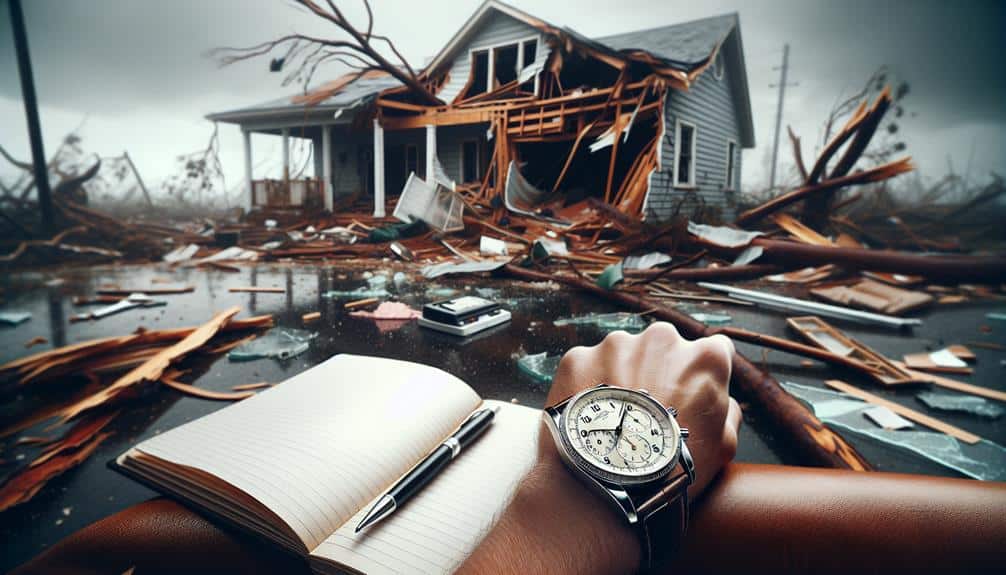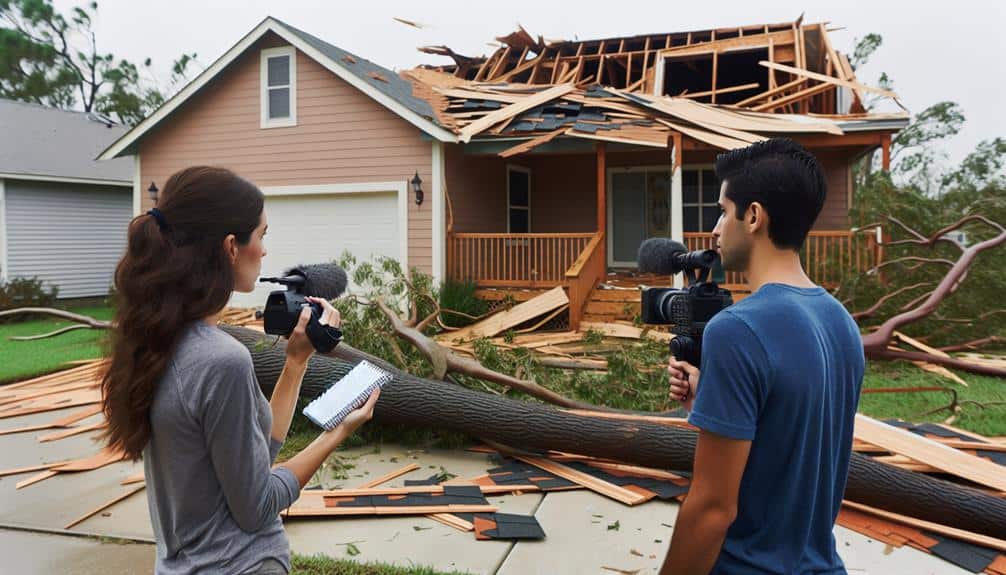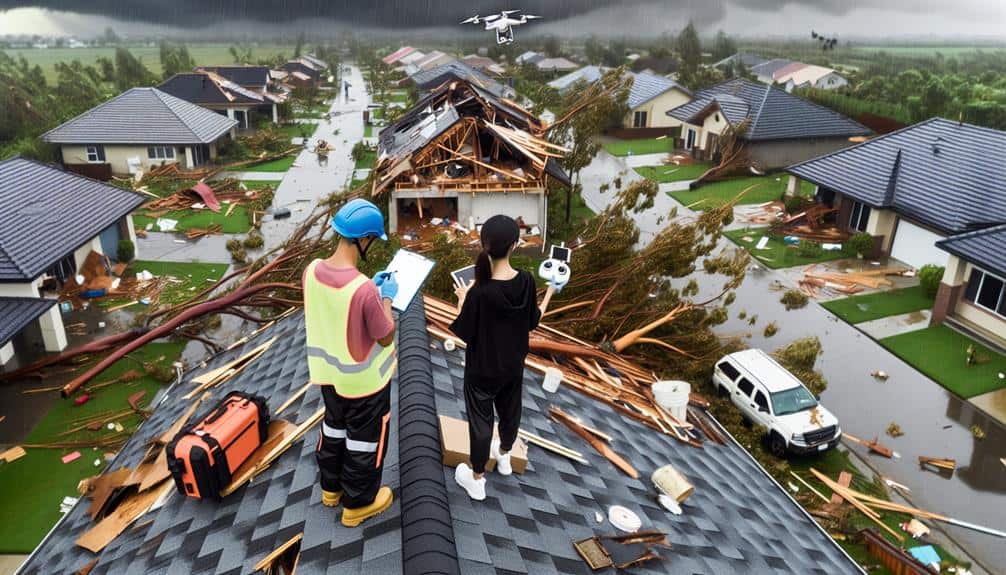We understand the importance of documenting storm damage accurately for insurance claims and legal purposes. Start by ensuring all cameras and phones are fully charged and have ample storage. Capture high-quality photos and videos from various angles, including wide shots and close-ups. Record time stamps, weather conditions, and use GPS tagging for precise documentation. Interview witnesses for additional insights and create a detailed inventory of property damage. Organize your evidence systematically and contact local authorities to report promptly. By following these steps, you're well-prepared to manage the aftermath of a storm effectively and may discover further important details.
Key Points
- Always capture high-resolution photos and videos from multiple angles to ensure clear and detailed documentation of storm damage.
- Use GPS tagging and time stamps to accurately track the location and timing of each documented damage.
- Interview witnesses to gather multiple perspectives and corroborate evidence of the storm's impact.
- Organize all evidence systematically, including detailed notes and categorized folders, for easy reference and thorough documentation.
Prepare Your Equipment
Before we begin documenting storm damage, let's make sure all our equipment is properly prepared and functioning. Effective equipment maintenance is key to ensuring we capture accurate and thorough documentation.
First, check that our cameras and mobile devices are fully charged and equipped with sufficient memory storage. We should also bring spare batteries and memory cards to avoid interruptions.
Next, let's inspect our tools for any signs of wear and tear. This includes checking the condition of our camera lenses, cleaning them if necessary, and verifying that all protective cases are intact and waterproof. A reliable tripod can be vital for steady shots, so ensuring it's in good working order is essential.
In terms of storm preparedness, having a portable power bank and waterproof bags for our equipment can make a significant difference. Additionally, using a durable, weather-resistant notebook can help us take essential notes even in adverse conditions.
Ensure Personal Safety
Our top priority must be securing our personal safety while documenting storm damage. It's vital that we take safety precautions seriously to avoid unnecessary risks.
Before heading out, we should familiarize ourselves with local evacuation routes and shelter locations. Knowing where to go in case conditions worsen will provide an essential safety net.
We should also confirm our phones are fully charged and have a list of emergency contacts readily accessible. This allows us to reach out for help if needed.
Wearing appropriate clothing and sturdy footwear can prevent injuries from debris that might be scattered around the storm-damaged areas.
Let's not forget to check the weather forecast continuously. Sudden changes can pose additional hazards, so staying informed helps us make the best decisions.
If we encounter downed power lines, we should maintain a safe distance and report them to the authorities immediately.
Another important consideration is to work in pairs, if possible. Having someone else with us can make a significant difference in case an emergency arises.
Capture High-Quality Photos
To effectively document storm damage, we need to capture high-quality photos that accurately reflect the extent of the destruction. First, let's make sure our camera or smartphone is set to the highest resolution. Higher resolution photos offer more detail, making it easier to assess damage later on.
Next, we should pay close attention to lighting techniques. Natural light is ideal, so taking photos during daylight hours will yield the best results. If natural light is insufficient, using a flashlight or camera flash can help illuminate darker areas, guaranteeing all details are visible.
Positioning is vital. We should take photos from multiple angles—front, sides, and close-ups of specific damage points. This inclusive approach helps us capture the full scope of the damage. Wide shots can show the overall scene, while close-ups can highlight specific issues, like cracks or broken elements.
Record Detailed Videos
Recording detailed videos allows us to capture a dynamic and thorough view of the storm damage. Videos provide a complete perspective that static photos might miss, showcasing the extent of the damage and giving context to the affected areas.
As we record, it's vital to walk slowly, focusing on both wide shots and close-ups to highlight specific details. This guarantees we cover the entire scope of the damage, from structural issues to minor debris.
Using editing software, we can enhance our videos by trimming unnecessary parts and highlighting crucial sections. This makes the footage more concise and impactful, aiding both personal review and insurance claims. It's imperative to label and organize our videos systematically, making them easier to retrieve and review later.
Equally important is creating backup footage. We should save our videos on multiple platforms, such as cloud storage and external hard drives. This redundancy protects our documentation from accidental loss or technical failures, ensuring we always have access to our vital evidence.
Note Date and Time

Let's make sure we capture exact time stamps when documenting storm damage. By recording the precise date and time, we can accurately track the sequence of events.
Additionally, noting the weather conditions at those times helps create a detailed and dependable record.
Capture Precise Time Stamps
Accurately noting the date and time of storm damage is pivotal for a thorough record. When we document storm damage, capturing precise time stamps is essential. This practice allows us to correlate the damage with specific weather patterns and facilitates data analysis. By doing so, we create a clear, chronological account that can be invaluable for both insurance claims and potential legal proceedings.
For evidence collection, having exact time stamps strengthens our case, providing a solid foundation that depicts the sequence of events. This can be vital when dealing with legal implications, as it offers concrete proof of when the damage occurred.
We should always use reliable methods to note the date and time, such as a camera with a timestamp feature or a digital log that records the exact moment each piece of evidence is captured.
Record Weather Conditions
To effectively document storm damage, we must also note the prevailing weather conditions, including the exact date and time. This information is pivotal for accurate data analysis and understanding weather patterns that led to the damage. By meticulously recording these details, we can establish a clear timeline and context for the storm's impact.
Here are four essential steps to follow:
- Check Weather Reports: Refer to local weather reports and forecasts to capture precise details about the storm. This includes wind speeds, precipitation levels, and any weather warnings issued.
- Use Technology: Utilize weather apps and online resources to get real-time updates. These tools can provide detailed information on weather patterns and can be invaluable for accurate documentation.
- Photograph Weather Conditions: Take photographs that include visible weather elements, such as dark clouds, rain, or fallen debris. Make sure to timestamp these images for better data correlation.
- Document Every Detail: Write down observations about the weather, such as lightning, hail, or sudden temperature changes. Include the exact date and time to enhance the reliability of your data analysis.
Use GPS Tagging
When we document storm damage, activating location services on our devices can provide precise GPS tagging. This allows for accurate time stamping and ensures we're able to map damage areas effectively.
Enable Location Services
Enabling location features on your device allows us to utilize GPS tagging for precise documentation of storm damage. By activating location services, we can guarantee that our photos and videos have accurate coordinates, which is vital for evaluating the impact of the storm. This not only improves location accuracy but also aids in streamlining the claims process with insurance companies and authorities.
However, we acknowledge that privacy concerns might arise when activating these services. It's crucial to manage and control your data effectively.
Here are four steps to activate location features while safeguarding your privacy:
- Check App Permissions: Make sure only reliable apps have access to your location. You can usually customize this in your device's settings.
- Use Airplane Mode When Not Documenting: This can limit your device's ability to track your location when you're not actively documenting damage.
- Regularly Review Location History: Many devices allow you to view and delete your location history to uphold privacy.
- Use Location Features Sparingly: Enable it only when necessary for documenting storm damage, and disable it when finished.
Accurate Time Stamping
Accurate time stamping, supported by GPS tagging, guarantees that each documented instance of storm damage is precisely recorded with both the exact time and location. This dual functionality not only strengthens the data integrity of our reports but also provides robust legal evidence when claims are submitted. Ensuring that our documentation is time-stamped and GPS-tagged means that every detail we capture can be authenticated, bolstering the proof accuracy needed for effective claims processing.
When we use GPS tagging to timestamp our photos and notes, it serves as undeniable evidence authentication. This is pivotal when presenting our case to insurance companies or in legal contexts. The exact time and location data aid in eliminating any doubts regarding the authenticity of the documented damage. By maintaining this level of detail, we uphold the highest standards of data integrity, which can notably influence the outcome of our claims.
For those of us who value freedom and efficiency, leveraging technology for accurate time stamping and GPS tagging simplifies the documentation process. It allows us to confidently navigate the complexities of storm damage reporting, knowing that our information is precise and reliable.
Mapping Damage Areas
Building on the precision of time stamping, we can effectively map damage areas by utilizing GPS tagging to create thorough and accurate geographical representations of storm impact. GPS tagging allows us to gather essential geospatial data, which, when combined with other documentation methods, greatly enhances the accuracy of our damage assessment.
By integrating GPS tagging into our documentation process, we achieve the following:
- Exact Location Identification: GPS tagging pinpoints the precise location of damage, facilitating targeted repair efforts and resource allocation.
- Enhanced Data Accuracy: Combining geospatial data with visual and written records ensures no detail is overlooked, providing a detailed damage overview.
- Efficient Reporting: Accurate maps created from GPS data streamline the reporting process, making it easier to communicate the extent and specific areas of damage to stakeholders.
- Improved Historical Records: GPS-tagged data creates reliable historical records that can be referenced for future planning and mitigation strategies.
Using GPS tagging empowers us to collect detailed, accurate data, enabling a nuanced understanding of storm damage. This approach not only aids immediate recovery efforts but also supports long-term resilience planning, giving us the flexibility to respond more effectively to future events.
Interview Witnesses

Interviewing witnesses provides necessary firsthand accounts that can help us understand the extent and specifics of storm damage. By conducting witness interviews, we're able to gather testimonies that offer unique perspectives on the incident. These narratives can often reveal details that mightn't be immediately apparent through physical inspection alone.
To ensure the dependability of these accounts, we need to perform a credibility assessment for each witness. This involves asking precise questions and cross-referencing their statements with other evidence.
When gathering testimonies, it's vital to verify the accuracy of the information provided. We should document the time, date, and specific location of each interview, as well as any distinguishing characteristics of the witnesses themselves. This systematic approach helps us filter out any discrepancies or inconsistencies that might arise. Additionally, obtaining multiple accounts from different witnesses can provide a broader and more detailed picture of the damage.
We must approach each interview with an open mind and a keen eye for detail. By being thorough in our questioning and careful in our documentation, we can compile a detailed and reliable record of the storm's impact. This meticulous process empowers us to present a clear and accurate account of the events.
Document Property Damage
To effectively document property damage, we must conduct a thorough assessment of the affected areas. This process guarantees that we capture all necessary details for insurance coverage and address any potential legal implications.
Here's a structured approach to get started:
- Photograph Everything: We should take clear, high-resolution photos of all damaged areas. This includes both wide shots to show context and close-ups to highlight specific damage. Photos are essential for insurance claims and can be used in legal proceedings if necessary.
- Create a Detailed Inventory: Document every damaged item by making a detailed list. Include descriptions, approximate values, and any relevant purchase information. This inventory will be vital when filing for insurance coverage.
- Record the Extent of Damage: Writing detailed notes about the damage, such as the type and extent, helps paint a full picture. We can use these notes to support our claims and guarantee that nothing is overlooked.
- Collect Witness Statements: If possible, gather statements from neighbors or anyone who witnessed the storm. These testimonies can add credibility to our documentation and assist in addressing any legal implications that arise.
Organize Your Evidence

Once we've gathered all our documentation, it's important to systematically organize the evidence to make certain it's easily accessible and thorough.
First, we need to categorize our digital evidence by type: photos, videos, and scanned documents. Creating separate folders on our computers or cloud storage for each category will streamline the process. Label each file descriptively, including the date and a brief depiction of the content, such as 'Roof Damage_2023-10-12' or 'Water Damage_Living Room_2023-10-12.'
Next, we should compile a detailed inventory list that includes every piece of evidence. This list can be a simple spreadsheet that specifies the file name, type of damage, location, and any additional notes. This step aids in quick reference and guarantees we don't overlook any critical details.
For physical documents, scanning and digitizing them is essential. Digital evidence isn't only easier to share but also less likely to be lost or damaged. We should back up all digital files in multiple locations, like an external hard drive and a secure cloud service, to ensure redundancy.
Report To Authorities
We should promptly contact local authorities to report storm damage.
It's important to provide detailed information, including photos, videos, and specific descriptions of the damage.
This guarantees that the authorities can assess the situation accurately and take appropriate action.
Contact Local Authorities
Frequently, it's important to promptly inform local authorities about any storm damage to guarantee public safety and expedite recovery efforts. By contacting local authorities, we secure that emergency response teams are deployed quickly and that the community remains safe.
To efficiently reach out to local authorities, follow these steps:
- Identify the correct agency: Determine whether you need to contact the police, fire department, or local emergency management office. Each agency has a specific role in emergency response.
- Use official channels: Call the non-emergency number if the situation isn't life-threatening. In cases of immediate danger, always dial 911. Utilize official websites or mobile apps provided by local authorities for reporting.
- Provide essential details: Give a concise description of the damage, including the location and any immediate hazards. This helps authorities prioritize their response for public safety.
- Follow up: Secure your report has been received and ask for any further instructions. Staying in touch can facilitate a coordinated response and keep you informed about ongoing recovery efforts.
Provide Detailed Information
After contacting the appropriate local authorities, it's essential to provide detailed information to guarantee an efficient and effective response. We need to meticulously document the storm damage to ensure our insurance claims are processed swiftly. Begin by describing the extent of the damage, noting affected structures, vehicles, and any other property. Use photographs and videos to support your descriptions, capturing multiple angles and close-ups to provide a thorough view.
When reporting, include the date and time the storm occurred, as well as any immediate actions taken to mitigate further damage. This helps in the damage assessment process and can be crucial in preserving evidence for legal implications. Record conversations with authorities and insurance representatives, and keep copies of all correspondence and reports.
Additionally, list any witnesses who can corroborate the details of the damage. Their testimonies can reinforce our claims and aid in evidence preservation. Clear, detailed reports not only expedite the insurance claims process but also minimize potential legal disputes.
Frequently Asked Questions
How Can I Store My Documentation Securely to Prevent Data Loss?
To store our documentation securely and prevent data loss, let's use cloud storage for remote access and redundancy. We should also maintain physical backups, ensuring they're kept in a safe, accessible location for added security.
What Should I Do if I Miss Documenting Some Damage Initially?
If we miss documenting some damage initially, we'll conduct a thorough damage assessment and perform retrospective documentation. This guarantees all overlooked issues are recorded accurately, maintaining a detailed record for effective remediation and future reference.
Are There Specific Apps Recommended for Storm Damage Documentation?
For documenting storm damage, we recommend apps that offer photo evidence, timestamp verification, GPS tracking, and cloud storage. These features guarantee our documentation is accurate, verifiable, and securely stored, giving us the freedom to focus on recovery.
How Can I Ensure My Documentation Is Admissible for Insurance Claims?
To guarantee our documentation meets admissibility standards and avoids legal implications, we should timestamp photos, keep detailed records, and use reliable apps. Proper documentation helps streamline the claim process and secures our insurance coverage efficiently.
What Types of Documentation Are Most Effective for Legal Purposes?
For legal purposes, we should focus on video evidence and written reports. Witness statements and property records are also important. These types of documentation bolster our claims, ensuring they're thorough and admissible in court.


